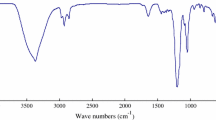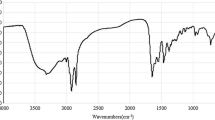Abstract
Enhanced crude oil recovery by chemical flooding has been a main measure for postponing the overall decline of crude oil output in China, and surfactant-polymer (SP) flooding may replace alkali-surfactant-polymer flooding in the future for avoiding the undesired effects of using alkali. In this paper the synthesis of a surfactant with a large hydrophobe, didodecylmethylcarboxyl betaine (diC12B), and its adaptability in SP flooding were investigated. The results show that diC12B can be synthesized by reaction of didodecylmethyl amine, a product commercially available, with chloroacetic acid in the presence of NaOH, with a resulting yield as high as 80 wt% under appropriate conditions. With double dodecyl chain diC12B is highly surface active as displayed by its low CMC, 3.7 × 10−6 mol L−1, low γCMC, 27 mNm−1, as well as high adsorption and small cross section area (≤0.25 nm2) at both air/water and oil/water interfaces at 25 °C. By mixing with conventional hydrophilic surfactants diC12B can be well dissolved in Daqing connate water and reduce the Daqing crude oil/connate water interfacial tension to about 10−3 mN m−1 at 45 °C in a wide total surfactant concentration range, from 0.01 to 0.5 wt%. And a tertiary oil recovery, 18 ± 1.5 % OOIP, can been achieved by SP flooding using natural cores without adding any alkaline agent or neutral electrolyte. DiC12B seems thus to be a good surfactant for enhanced oil recovery by SP flooding.












Similar content being viewed by others
References
Höök M, Tang X, Pang XQ, Aleklett K (2010) Development journey and outlook of Chinese giant oilfields. Petrol Explor Dev 37:237–249
Egbogah EO (1994) EOR target oil and techniques of its estimation. J Petroleum Sci Eng 10:337–349
Babadagli T (2007) Development of mature oil fields—a review. J Petroleum Sci Eng 57:221–246
Adasani AA, Bai B (2011) Analysis of EOR projects and updated screening criteria. J Petroleum Sci Eng 79:10–24
Hirasaki GJ, Miller CA, Puerto M (2008) Recent advances in surfactant EOR. Paper SPE 115386. Presentation in International Petroleum Technology Conference, Kuala Lumpur, Malaysia, 3–5 December 2008
Nedjhioui M, Moulai-Mostefa N, Morsli A, Bensmaili A (2005) Combined effects of polymer/surfactant/oil/alkali on physical chemical properties. Desalination 185:543–550
Carrero E, Queipo NV, Pintos S, Zerpa LE (2007) Global sensitivity analysis of alkali-surfactant-polymer enhanced oil recovery process. J Petroleum Sci Eng 58:30–42
Taylor KC, Nasr-El-Din HA (1996) The effect of synthetic surfactants on the interfacial behaviour of crude oil/alkali/polymer systems. Colloid and Surf A 108:49–72
Chatterjee J, Wasan DT (1998) A kinetic model for dynamic interfacial tension variation in an acidic oil/alkali/surfactant system. Chem Eng Sci 53:2711–2725
Chatterjee J, Wasan DT (1998) An interfacial model for mixed adsorbed for a ternary system application to an acidic oil/alkali/surfactant system. Colloid Surf A 132:107–125
Dong MZ, Ma SZ, Liu Q (2009) Enhanced heavy oil recovery through interfacial instability: a study of chemical flooding for Brintnell heavy oil. Fuel 88:1049–1056
Cao Y, Li H (2002) Interfacial activity of a novel family of polymeric surfactants. Euro Polym J 38:1457–1463
Liu Q, Dong M, Zhou W, Ayub M, Zhang YP, Huang S (2004) Improved oil recovery by adsorption–desorption in chemical flooding. J Petroleum Sci Eng 43:75–86
Yang J, Qiao W, Li Z, Cheng L (2005) Effects of branching in hexadecylbenzene sulfonate isomers on interfacial tension behavior in oil/alkali systems. Fuel 84:1607–1611
Zhang S, Yan J, Qi H, Luan J, Qiao W, Li Z (2005) Interfacial tensions of phenyltetradecane sulfonates for enhanced oil recovery upon the addition of fatty acids. J Petroleum Sci Eng 47:117–122
Zhang H, Dong M, Zhao S (2010) Which one is more important in chemical flooding for enhanced court heavy oil recovery, lowering interfacial tension or reducing water mobility? Energy Fuels 24:1829–1836
Jian YH, Xu ZG, Qiao WH, Li ZS, Cheng LB (2004) Research on synthesis and performance of novel modified lignosulfonate surfactants. J Dalian Univ Technol 44(1):44–47 (Ch)
Guo WK, Yang ZY, Wu XL, Zhang GY, Wang HF (2006) New type weak alkali surfactant applied to tertiary oil recovery. Acta Petrol Ei Sinica 27:75–78 (Ch)
Hou JR, Liu ZC, Yue XA (2006) Effect of multisystem ultralow interfacial tension and alkali in oil displacement process. PGODD 25:82–86 (Ch)
Cui ZG, Zou WH, Zhang TL, Zhang DG (1999) Synthesis of heavy alkylbenzene sulfonates and their applications in enhanced oil recovery. J East China Univ Sci Technol (Natural Science Edition) 25:339–346 (Ch)
Yue XY, Lou ZH, Han D, Yuan SY (2004) Synthesis and properties of petroleum sulfonates surfactant for weak-base system for EOR. Adv Fine Petrochem 5:7–10 (Ch)
Han M, Kang XD, Zhang J, Xiang WT (2006) Progress in EOR by means of surfactants. China Offshore Oil Gas 18:408–412 (Ch)
Zhao FL (2007) Research advances of chemicals for oil production. J China University Petroleum 31:163–172 (Ch)
Chiu YC, Kuo PR (1999) An empirical correlation between low interfacial tension and micellar size and solubilization for petroleum sulfonates in enhanced oil recovery. Colloids Surf A 152:235–244
Berger PD, Lee CH (2002) Ultra low concentration surfactants for sandstone and limestone floods. SPE 75186. Presented at the 2002 SPE/DOE improved oil recovery symposium, Tulsa Oklahoma, 13–17 April 2002
Zhang S, Xu Y, Qiao W, Li Z (2004) Interfacial tensions upon the addition of alcohols to phenylalkane sulfonate monoisomer systems. Fuel 83:2059–2063
Rosen MJ, Wang H, Shen P, Zhu Y (2005) Ultralow interfacial tension for enhanced oil recovery at very low surfactant concentrations. Langmuir 21:3749–3756
Xu Z, Li P, Qiao W, Li Z, Cheng L (2006) Effect of aromatic ring in the alkyl chain on surface properties of arylalkyl surfactant solutions. J Surf Deterg 9:245–248
Zhao Z, Liu F, Qiao W, Li Z, Cheng L (2006) Novel alkyl methylnaphthalene sulfonate surfactants: a good candidate for enhanced oil recovery. Fuel 85:1815–1820
Aoudia M, Al-Shibli MN, Al-Kasimi LH, Al-Maamari R, Al-Bemani A (2006) Novel surfactants for ultralow interfacial tension in a wide range of surfactant concentration and temperature. J Surf Deterg 9:287–293
Iglauer S, Wu Y, Shuler P, Tang Y, Goddard WA III (2009) Alkyl polyglycoside surfactant-alcohol cosolvent formulations for improved oil recovery. Colloids Surf A 339:48–59
Iglauer S, Wu Y, Shuler P, Tang Y, Goddard WA III (2010) New surfactant classes for enhanced oil recovery and their tertiary oil recovery potential. J Petroleum Sci Eng 71:23–29
Cui ZG, Song HX, Yu JJ, Jiang JZ, Wang F (2011) Synthesis of N-(3-oxapropanoxyl) dodecanamide and its application in surfactant–polymer flooding. J Surf Deterg 14:317–324
Wu WX, Yan W, Liu CD (2007) The results of core flooding experiment by sulfobetaine/polymer combinational system. Oilfield Chem 24(57–59):60–62 (Ch)
Xia HF, Wang G, Ma WG, Liu CD, Wang YW (2008) Influence of viscoelasticity and interfacial tension of non-alkali binary compound solution on recovery efficiency of residual oil after water flooding. Acta Petrol Ei Sinica 29:106–115 (Ch)
Ma T, Shao HY, Wang HB, Jiang P, Wei TJ, Tang DZ (2008) A laboratory study of the composite two-component oil-displacement system without alkali. China Offshore Oil Gas 2:41–47 (Ch)
Chen H, Han L, Luo P, Ye Z (2004) The interfacial tension between oil and Gemini surfactant solution. Surf Sci 552:L53–L57
Bourrel M, Schechter RS (1988) Microemulsion and related systems: formulation, solvency, and physical properties. Surfactant Sciences Series Vol. 30. Marcel Dekker, Inc., New York and Basel
Salager JL, Morgan JC, Schechter RS, Wade WH, Vasquez E (1979) Optimum formulation of surfactant/water/oil systems for minimum interfacial tension of phase behavior. Soc Pet Eng J 19:107–115
Arandia MA, Forgiarini AM, Salager JL (2010) Resolving an enhanced oil recovery challenge: optimum formulation of a surfactant-oil-water system made insensitive to dilution. J Surf Deterg 13:119–126
Cui ZG, Wu L, Sun MM, Jiang JZ, Wang F (2011) Synthesis of dodecyllauroylbenzene sulfonate and its application in enhanced oil recovery. Tenside Surf Deterg 48:408–414
Adkins SS, Chen X, Nguyen QP, Sanders AW, Johnston KP (2010) Effect of branching on the interfacial properties of nonionic hydrocarbon surfactants at the air-water and carbon dioxide-water interfaces. J Colloid Interface Sci 346:455–463
Longman GF (1975) The analysis of detergents and detergent products. Wiley, New York, p 237
Liao CW, Zhang WY, Wang HJ, Cui ZG (2010) Determination of active matter and free tertiary amine contents in alkylcarboxybetaine product by direct titration methods. China Surf Deterg Cosmet 41:68–72 (Ch)
Rosen MJ (2004) In surfactants and interfacial phenomena, 3rd edn. Wiley, New York, pp 27–28
Wade WH, Morgan JC, Schechter RS, Jacobson JK, Salager JL (1978) Interfacial tension and phase behavior of surfactant systems. SPEJ 18:242–252
Chan KS, Shah DO (1980) The molecular mechanism for achieving ultralow interfacial tension minimum in a petroleum sulfonate/oil/brine system. J Dispers Sci Technol 1:55–95
Shinoda K, Friberg S (1986) In emulsion and solubilization. Wiley, New York
Salager JL (1996) Quantifying the concept of physico-chemical formulation in surfactant -oil-water systems—state of the art. Program Colloid Polym Sci 100:137–142
Acknowledgments
The authors thank the Laboratory of Oil Recovery, Institute of Petroleum Exploring and Development of Daqing, China, for financial support and the measurement of oil recovery using natural cores. The authors also thank Miss Shan Cheng, Miss Wen-yan Zhang, and Mr. Chuan-wen Liao, who did parts of the experimental work as M.Sc. students.
Author information
Authors and Affiliations
Corresponding author
About this article
Cite this article
Cui, Zg., Du, Xr., Pei, Xm. et al. Synthesis of Didodecylmethylcarboxyl Betaine and Its Application in Surfactant–Polymer Flooding. J Surfact Deterg 15, 685–694 (2012). https://doi.org/10.1007/s11743-012-1396-2
Received:
Accepted:
Published:
Issue Date:
DOI: https://doi.org/10.1007/s11743-012-1396-2




